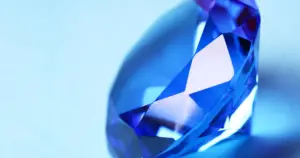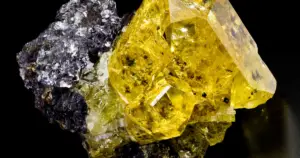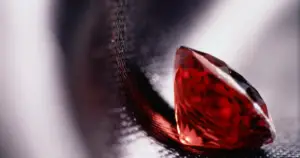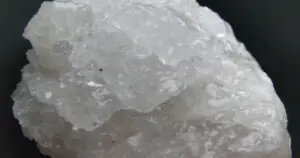Mimetite Meaning: Healing Properties, Benefits and Uses
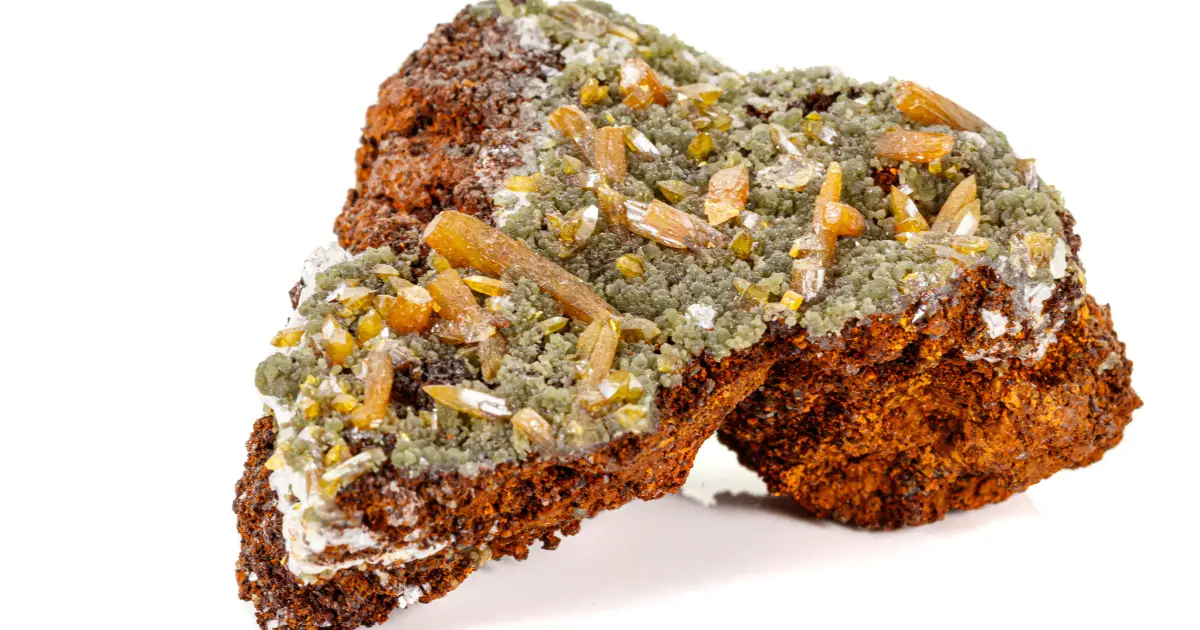
Mimetite is an uncommon secondary mineral made up of lead chloride and arsenate in the form of hexagonal crystals that resemble white or yellowish needles. Indication: Pb5Cl (AsO4) 3. An uncommon lead arsenate chloride mineral called mimetite, also known as Mimetite and Prixite, crystallises as botryoidal, tiny tabular crystals, and tiny curved acicular crystals.
This apatite-family mineral is created when lead deposits undergo extensive oxidation. Lead chloro-arsenate mineral mimetite is minor lead ore. Along with Pyromorphite and Vanadinite, Mimetite belongs to the Apatite group. Mimetite seldom forms crystals; instead, it is typically found as crusts.
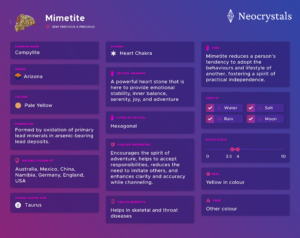
Table of Contents
What is Mimetite?
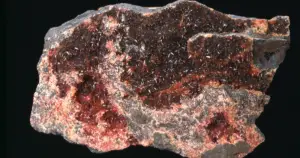
The word mimetite, which means “imitator,” is derived from the Greek mimetes and relates to how similar the mineral is to pyromorphite. This similarity is not accidental because mimetite, pyromorphite, and vanadinite (Pb5(VO4)3Cl) are all members of the same mineral series. The Greek word “mimetes” means “imitator,” and F.S. Beaudant originally described this crystal in 1832. This name was chosen because the two minerals naturally formed close to one another and share a similar appearance to pyromorphite.
Mimetite is found in aggregates that are botryoidal, granular, tabular, and acicular. Mimetite is a secondary mineral that forms in lead deposits that have undergone oxidation as well as other locations where lead and arsenic coexist. Due to its likeness to pyromorphite, the Greek word “mimetes,” which means “imitator,” gave rise to the name “mimetite.”
How to identify a Mimetite?
Mimetite can typically be easily recognised from more frequently found gemstones attributed to its over-the-limit (OTL) refractive indices of 2.128 and 2.147, extremely high specific gravity (SG) of 7.24, and piezoelectric capabilities. However, it also resembles a few other uncommonly faceted gemstones, including cassiterite, vanadinite, and wulfenite, in terms of some of these traits as well as colour ranges. Compared to mimetite, cassiterite and vanadinite often have lower specific gravities (SG). However, if calcium (Ca) replaces lead (Pb) in its composition, mimetites may have lower SG values. Mimetites also share or closely resemble the colours and characteristics of pyromorphites.
On Moh’s scale of mineral hardness, mimetite is assessed as having a hardness of 3.5 to 4. The colour spectrum of mimetite includes hues of yellow, orange, brown, and occasionally green or colourless.
Mimetite Cuts
Few transparent mimetite crystals have ever been faceted, making them exceptionally rare. Although this material has been cut into cabochons with vibrant orange and yellow colours, it is too soft to be worn as jewellery. From globular Mexican mimetites, gem cutters have created strange, intriguing cabochons up to a couple of inches in length.
Transparent crystals are highly rare and are typically conserved as mineral specimens rather than cut, especially those from Tsumeb. Small shattered crystals have, however, been cut, producing some stones that weigh up to a few carats, and a maximum of 5-7 carats.
Mimetite Shapes
Mimetite crystals that are transparent are extremely uncommon, and only a few have ever been faceted. Although this material has been cut into cabochons with vivid orange and yellow colours, it is too soft to be worn as jewellery. Mimetite or pyromorphite that crystallises as discrete barrel-shaped crystals forming curving hemispherical aggregates is known as campylite.
Formerly known as Belite, this chromium-containing mimetite—or perhaps a combination of crocoite, mimetite, and quartz—which crystallises in gorgeous orange-red crystals has been debunked as a separate species of mineral.
Where is Mimetite Found?
- Minerals such as pyromorphite, cerussite, hemimorphite, smithsonite, vanadinite, anglesite, pyrite, mottramite, willemite, and wulfenite are also found in combination with mimetite.
- The United States Gila County in Arizona, Mexico’s Ojocaliente, England’s Cumberland, Germany’s Johanngeorgenstadt, Namibia’s Namibia, and Australia’s Broken Hill have all reported having good specimens. Despite being found in Australia, Greece, and the USA, mimetite has been found in very excellent specimens in Mexico and Namibia.
- Up to one inch long, fine, golden, transparent crystals have been found near Tsumeb, Namibia. The majority of the scarce face table content comes from this.
- Fine globular masses of orange and yellow are produced in Chihuahua and Mapimi, Durango, Mexico.
- England’s Cornwall and Cumberland (a subregion known as campylite); Scotland.
Mimetite Stone Meaning
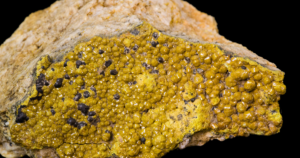
Mimetite, also known as lead chloroacetate, is a rare mineral that often appears in globular and botryoidal forms in the oxidised zones of lead deposits. It is sought for its scarcity, rare colouration, peculiar crystal structure, and frequent interaction with other vibrant minerals like pyromorphite and vanadinite.
Mimetite Meaning in Ancient Lore and History
The Greek word “mimetes,” which means “imitator,” was used to name this crystal when it was first described by F.S. Beaudant in 1832 about its resemblance to pyromorphite. Mimetite can also be found with other minerals such as calcite, galena, smithsonite, and wulfenite in addition to pyromorphite and vanadinite.
Mimetite is relatively uncommon in the United States, even though it has been discovered in lead-bearing mines in Arizona. Near Durango, San Pedro Corralitos, and Cerro Prieto in Mexico, more numerous examples have been discovered. Particularly in Chihuahua, the San Pedro Corralitos region, botryoidal clusters that resemble yellow grapes have made exceptional specimens.
Johann Wolfgang von Goethe (1749–1832), a renowned German physicist, author, and statesman, characterised huge tabular crystals extracted from a mine near Johanngeorgenstadt, Saxony, Germany, which is now recognised as the mineral’s “type locality.” Old mines in Cornwall and Cumbia, England, are likewise regarded as great locations. Large gemmy crystals have lately been discovered in the Guangdong Province of China, the Northern Territory of Australia, and Tsumeb, Namibia.
Mimetite Healing Properties
- By enhancing the sense of adventure and easing all aspects of responsibility to a manageable level, mimetite can be used. Mimetite reduces a person’s propensity to mimic or replicate the behaviour, mannerisms, or way of life of another, which fosters a spirit of practical independence. One is guided to the source of wisdom by mimetite, which also offers security while acquiring knowledge. Mimetite makes channelling easier and improves communicator and receiver modes for precision and clarity.
- Mimetite can be used to treat skeletal and throat diseases as well as atrophy, immobility, and immobility issues.
- Apatite is a variant that includes mimetite, which, though typically yellow, can also be red, brown, or red-brown and, when yellow, exhibits many of the characteristics of golden apatite.
- If you have a lot of responsibilities, it could be helpful for you to feel confident in handling this aspect of your life.
- It is a protection stone that may be especially helpful to you if you are channelling. Its crystal meanings may inspire you to feel a spirit of adventure.
- It will improve your ability to communicate with spirit and make it easier for you to explain what was channelled precisely and clearly.
- It is a fascinating stone that is rumoured to have an impact only on the location where it resides.
- It is known to transform its current location into an energy vortex that fosters rebirth and rejuvenation.
Mimetite Metaphysical Properties
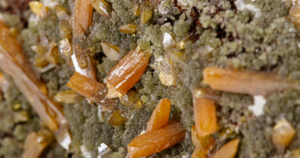
During meditation, mimetite can be utilised as protection.
- Mimetite improves psychic communication by making information received more accurate and clear.
- Mimetite encourages character freedom.
- Mimetite boosts one’s sense of adventure.
- Mimetite should act as a daily reminder to give oneself space, decompress, and practise meditation.
- To allow the energies to be immediately absorbed, try lying down and placing this stone over your heart. Imagine that this energy is clearing away one’s heart of any and all obstructions.
- Mimetite’s uplifting and energetic vibrations will quickly enter one’s body once one’s heart has been purified. One will be able to appreciate doing what one love again and experience happiness and delight thanks to this newly discovered energy.
Mimetite Benefits
Mimetite is a strong heart stone that brings emotional balance, inner tranquilly, joy, and adventure. It aids in heart opening and helps one let go of any negative energy that might be plaguing our most important organ.
Mimetite helps clear out negative energy while also supplying nourishing and reviving vibrations to fill one’s emotional body and auric field. As one’s body is filled with positive energy, the chakra field will realign and give general equilibrium. One will experience unadulterated delight and bliss thanks to these Mimetite deeds and energy.
Mimetite Benefits Spirituality
- The properties of mimetite are said to include mental communication, freedom, and adventure. It is believed to help with the therapy of weak, immobile, and atrophied muscles.
- Mimetite crystals have long been associated with cultural beliefs that claim they may treat human ailments.
- Crystal healing is a technique that makes use of the healing powers of mimetite. Some crystals are connected to important planets and draw their energy into the wearer’s body.
- The properties of mimetite are said to include mental communication, freedom, and adventure. It is believed to help with the therapy of weak, immobile, and atrophied muscles.
- Wulfenite is thought to be a stone of sexual desire, ritual magic, creativity, and the serenity prayer. It is thought to help with thyroid conditions as well as sexual dysfunction.
- Hemimorphite is regarded as a stone of individual potential, inner fortitude, joy, and fortitude. It is believed to help with nutrition and exercise, treat diseases of the reproductive system, lessen pain and ulcers, and ease ulcerative colitis.
Mimetite & Feng Shui
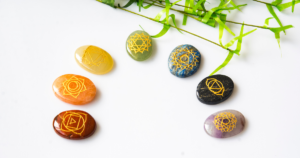
- A seeker buffer crystal is a Mimetite. When one wants to locate their centre, a place of rest, and a place of balance, they employ seeker buffer crystals.
- You may be forced far from your desired position when your life is out of order and demands are coming at you from all sides. To protect yourself from outside pressures, soften shocks, and give your daily life some emotional cushioning, use a Seeker Buffer crystal.
- You will be a lot happier living in this hectic world if you can discover the middle path of balance in your life with the aid of these gems.
Mimetite Birthstone
As the earth’s surface continues to warm in the spring, a growth frenzy transforms arid landscapes into lush glades, and the leaves of plants and trees begin to show in a myriad of green hues. These stones are “growth crystals,” just like their counterparts in the plant realm.
They serve as potent conduits for both the strength of nature’s ongoing renewal and the life-giving energy of the ground. These crystals serve as the natural birthstones for people who were blessed to be born in the springtime (April 20–May 20).
Mimetite Chakras
- The heart chakra and mimetite are related. Near the middle of the breastbone is where the heart chakra is situated.
- It controls how we interact with the outside world. It determines what we accept and reject. It equips us with the balancing ability to maintain a healthy distance from and involvement in the outside world.
- It strikes a balance between our environment and our inner self.
- When it is in harmony, we are open-minded, and welcoming, and interact with others and the demands of the outside world without difficulty.
- We can also easily strike a balance between our internal and exterior requirements since we are aware of when our needs are being jeopardised.
- We are capable of adjusting to the ups and downs of emotional connections, realising that they are cyclical, and accepting change.
- Mimetite is placed in the middle of a room or residence and is connected to the Earth. Placing fluorapatite crystals in the middle of a room will balance all the energy there, ensuring that equilibrium and harmony are upheld.
- Crystals of fluorapatite can also be utilised to deflect a poison arrow.
What are the Uses of Mimetite?
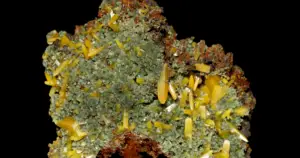
- Mimetite is a rare hexagonal crystal with properties resembling those of pyromorphite and vanadinite.
- It encourages the desire and readiness for the adventure your heart is urging you to take while giving you the power to find your own unique path. Additionally, mimetite shields you from harmful energy or psychic assault.
- It helps you obtain precise knowledge by opening psychic channels.
- Use one of these Mimetite Specimens whenever you require a dosage of assurance or security. Place it on your altar as a reminder of your uniqueness as your greatest gift and tap into its potent energy
- .All the qualities of apatite are present in mimetite. Additionally, mimetite reduces a person’s tendency to adopt the behaviours and lifestyle of another, fostering a spirit of practical independence.
- It is employed to heighten the spirit of exploration and to reduce all burdensome aspects of obligations to a “tolerable” level. It serves as a shield.
Caring for Mimetite
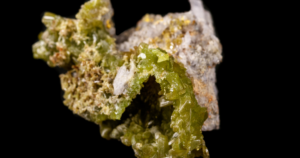
When to Cleanse Mimetite?
- Crystals are cleansed and charged by the pure energy of the moonlight. While you sleep, place your mimetite stone or necklace on a windowsill or other safe location that gets a lot of moonlight. Allow it to absorb the rays. It will be revived and rejuvenated in the morning.
- For a more powerful, long-lasting cleaning, clean your mimetite during a full moon.
- Make sure the area where you rest won’t cause it to roll away or be knocked to the ground.
- Stones and crystals can be swiftly cleansed with the help of sunlight. Even if it’s partly cloudy, set your crystal on a windowsill or in a secure location outside while the sun is out (as long as there’s natural light, you’re good). Approximately 30 minutes later, your mimetite will function like new.
- Mimetite is opaque and less prone to fading from prolonged exposure to sunlight than translucent crystals.
- Leave Mimetite outside at dawn or sunset so it may simultaneously absorb light from the sun and moon for an especially potent cleaning.
How to Recharge Your Mimetite?
Crystals are crystalline lattices made of dissolved minerals. Salts are an example of a crystalline chemical that may be beneficial or detrimental to health. It is believed that crystals can improve health by rebalancing the electromagnetic field of the body. You must charge your crystals beforehand to make sure they are prepared for a healing session. Making ensuring your crystals are sparkling clean and of superior grade is also useful.
Plants or soil can be used to encircle or bury your gem. You might wish to bury your crystal in the ground or plant it in your garden if you want your crystal to be charged with earth energy. Plants and dirt can assist surround your crystal to energise it with earth energy. If you want to bury your gem, erect a marker to serve as a reminder of its whereabouts.
Be energetic. There are numerous names for this. People may not always mean the same thing when they say “energy” to charge a crystal. The act of envisioning your aura, prana, chi, qi, or spirit entering the crystal is referred to as “directing one’s own energy into the object.” Many people assert that they can sense this taking place. Since it’s an intuitive process, you might want to rely on your own judgement or a mentor’s to know if you’re doing it well.
Mimetite Activation Process
Phosphate (PO3-4) replaces arsenate (AsO3-4) in the solid solution series that mimetite produces with pyromorphite. Since the two minerals’ characteristics are so similar, only laboratory studies can reliably separate them. The more prevalent mineral in most places is pyromorphite.
Mimetite or pyromorphite with unique barrel-shaped crystals that combine into curving hemispherical masses is known as campylite. The term “bellite” was once used to describe chromium-containing mimetite, or possibly a combination of crocoite, mimetite, and quartz, which crystallises in attractive orange-red crystals but has since been disproven as a separate mineral species.
A cross-section of a hexagonal prism of mimetite reveals a partition into six optically biaxial sectors or a complicated lamellated structure, whereas pyromorphite crystals, though often optically uniaxial, are occasionally biaxial.
How much is Mimetite worth?
Mimetite is worth $16.
What determines Mimetite’s price and value?
Mimetite”s Identifying characteristics determine price and value which makes this crystal rare and unique. Usually, the colour is yellow, orange, or brown; less frequently, the colour is green, colourless, or grey.
- Adobe to resinous is lustre.
- Crystals range from being transparent to translucent.
- Hexagonal crystal system; 6/m
- The barrel-shaped hexagonal prism with a hexagonal pyramid or a pinacoid as a terminal is a type of crystal habit. Classic botryoidal crusts, dazzling cauliflower-like aggregations, tiny connected spherical masses, or tiny spike-like crystals are more frequently encountered.
- Rarely is cleavage observed.
- It is a sub conchoidal fracture.
- Hardness is between 3.5 and 4 and specific gravity is at 7.1+. (very heavy for translucent minerals)
- Off-white streak.
Mimetite Impact
Mimetites were created by scientists for several uses, such as studies on the removal of arsenic from contaminated locations. However, this laboratory-produced substance has no known application in jewellery.
Does Mimetite make a good jewelry stone?
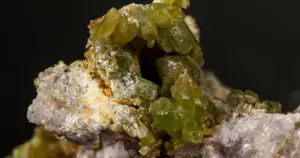
Yes, Mimetites make a good jewellery stone. Mimetites are frequently used by gem cutters to create cameos, intaglios, carvings, beads, and cabochons. These opaque, sub-metallic stones may occasionally be desired to be faceted with flat bases and few facets by gem aficionados (like classic marcasite).
Any cut mimetites, which have a hardness range of just 3.5 to 4, are typically kept for the show in gem collections. Memetics has a hardness ranging from 3.4 to 4, however, they are very fragile. Use protective settings to keep them safe from nicks and scratches as ring stones. Other applications, like pendants or brooches, shouldn’t call for any additional safeguards.
Mimetite Real vs Fake
Apatite and mimetite have comparable crystal structures, therefore occasionally the two minerals’ crystals will look alike. Along with two additional minerals, Pyromorphite (Pb5(PO4)3Cl) and Vanadinite (Pb5(VO4)3Cl), mimetite also forms a chemical series. Compared to typical chemical series, which entail switching out cations like calcium for magnesium, this series is a little unique.
Instead, this series replaces the anion groups phosphate (PO4), asenate (AsO4), and vanadate for its fundamental chemical components (VO4). Mimetite green or yellow Pyromorphite can make it challenging to distinguish between the two, but often mimetite is yellow and pyromorphite is green.
Typically, vanadinite is red. Fortunately, Mimetite rarely forms well-shaped crystals, especially ones that are green, making identification easier. It typically appears as a sparkling cauliflower cluster with a botryoidal crust. or as tiny crystals that resemble spikes.
FAQs
How do I know if I have Mimetite?
Mimetite has unique characteristics which are Mimetite can typically be easily recognised from more frequently found gemstones thanks to its extremely high specific gravity (SG) of 7.24 and piezoelectric capabilities. However, it also resembles a few other uncommonly faceted gemstones, including cassiterite, vanadinite, and wulfenite, in terms of some of these traits as well as colour ranges.
Mimetite has orange skin. She has three oval-shaped eyes, the main one being orange and the other two being dark blue and turquoise, respectively. Opal’s facial features and Mimetite’s full lips are surprisingly similar. Mimetite has red-banded, wavy hair that is dyed Princeton.
How much is Mimetite per carat?
Few transparent mimetite crystals have ever been faceted, making them exceptionally rare. Although this material has been cut into cabochons with vivid orange and yellow colours, it is too soft to be worn as jewellery. From globular Mexican mimetites, gem cutters have created strange, intriguing cabochons up to a couple of inches in length.
Transparent crystals are highly rare and are typically conserved as mineral specimens rather than cut, especially those from Tsumeb. Small shattered crystals have, however, been cut, producing some stones that weigh up to a few carats, and a maximum of 5-7 carats.
What is Mimetite made of?
Mimetite is a mineral having the chemical formula Pb5(AsO4)3Cl, which is a lead chloride arsenate. Lead deposits containing arsenic, it is a secondary mineral created by the oxidation of primary lead minerals. It often crystallises into short, compact hexagonal crystals that range in colour from yellow to brown to orange and have a Mohs hardness of 3.5 to 4. (specific gravity 7.24).
It stands out for three characteristics: a resinous to adamantine sheen, a lack of transparency, and solubility in nitric acid. Compared to typical chemical series, which entail switching out cations like calcium for magnesium, this series is a little unique.
Where can Mimetite be found?
Despite being found in Australia, Greece, and the USA, mimetite has been found in very excellent specimens in Mexico and Namibia. Minerals such as pyromorphite, cerussite, hemimorphite, smithsonite, vanadinite, anglesite, pyrite, mottramite, willemite, and wulfenite are also found in combination with mimetite. Good specimens have also been reported from Namibia, Broken Hill, Australia, Ojocaliente, Zacatecas, Mexico, Cumberland, England, and Johanngeorgenstadt, Saxony, Germany.
How rare are Mimetite mines?
An uncommon lead arsenate chloride mineral called mimetite, also known as mimetite and private, crystallises as botryoidal, tiny tabular crystals, and tiny curved acicular crystals. This apatite-family mineral is produced by the severe oxidation of lead deposits. They are rare crystals with abundant healing properties.
